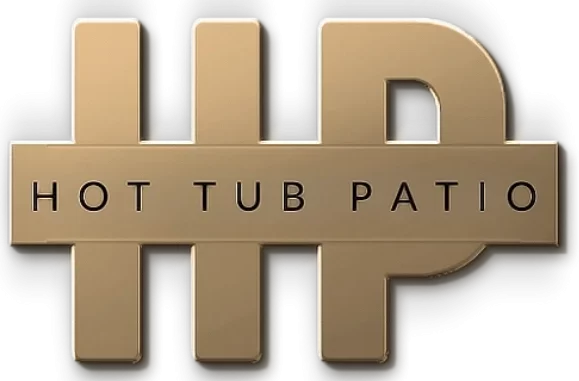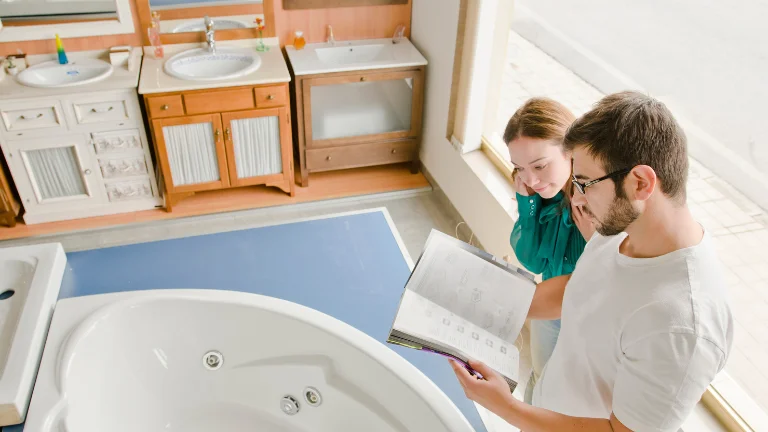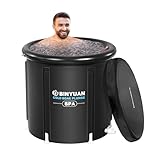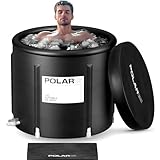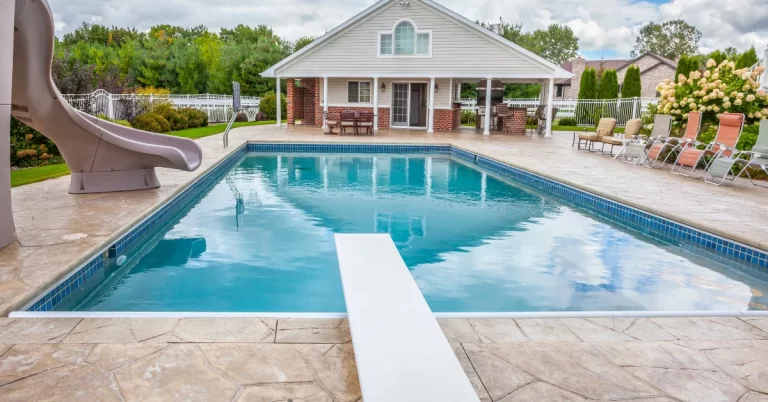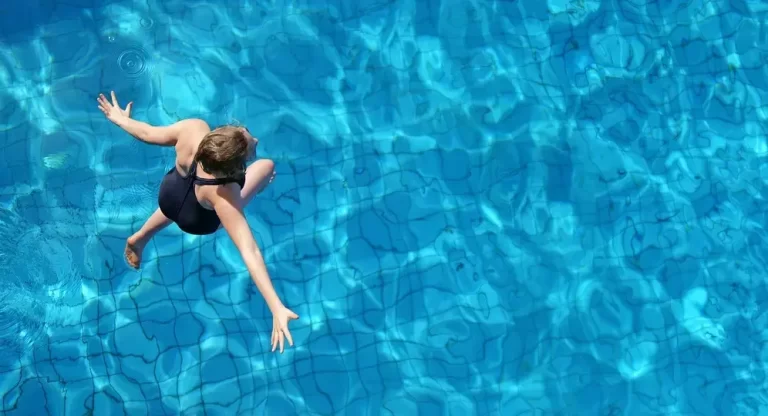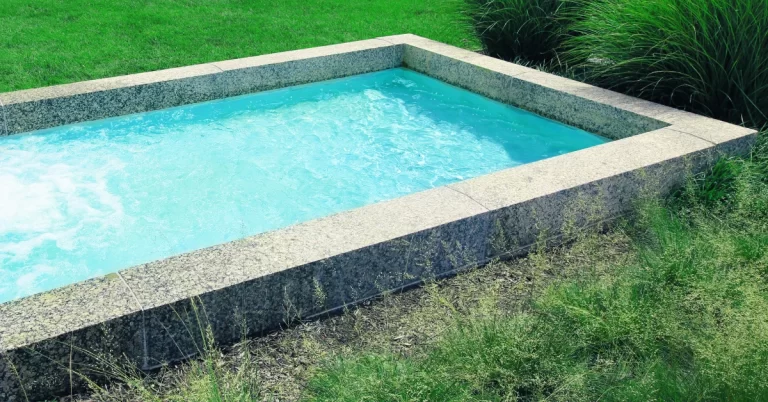Plunge Pool and Cold Plunge Guide: Costs, Types, and Smart Picks
A plunge pool is a small, deep pool designed for quick dips or relaxation, while a cold plunge is kept at a much lower temperature for recovery and therapy.
Cold plunges are small tubs designed to stay between 50°F and 59°F. Athletes use them to reduce inflammation, ease soreness, and boost mood after workouts. A 2024 study from the National Library of Medicine found that just two minutes of cold immersion can lower muscle fatigue by up to 25%.
This guide helps you compare costs, sizes, and features, so you can choose the right one for your space, wellness goals, and budget without wasting time or money.
- What Is a Plunge Pool Anyway?
- Cold Plunge vs Cocktail vs Regular Pools: What's the Difference?
- Plunge Pool Sizes, Shapes & Layouts
- Cost Breakdown & Buying Guide
- Find One or Stay Somewhere with One
- Pros, Cons & Who It's Not For
- Which Option Fits Your Lifestyle?
- How to Install a Plunge Pool (Step-by-Step)
- Real Example: Homeowner Case Study
- Plunge Pool Winter Maintenance
- FAQs
What Is a Plunge Pool Anyway?
A deep pool designed more for cooling off and relaxation than swimming laps. They’re usually compact (often 6 to 12 feet long and 4 to 7 feet deep), which makes them a popular pick for backyards that don’t have room for a full-size pool. You can soak, stretch, or chill without needing much space or water.
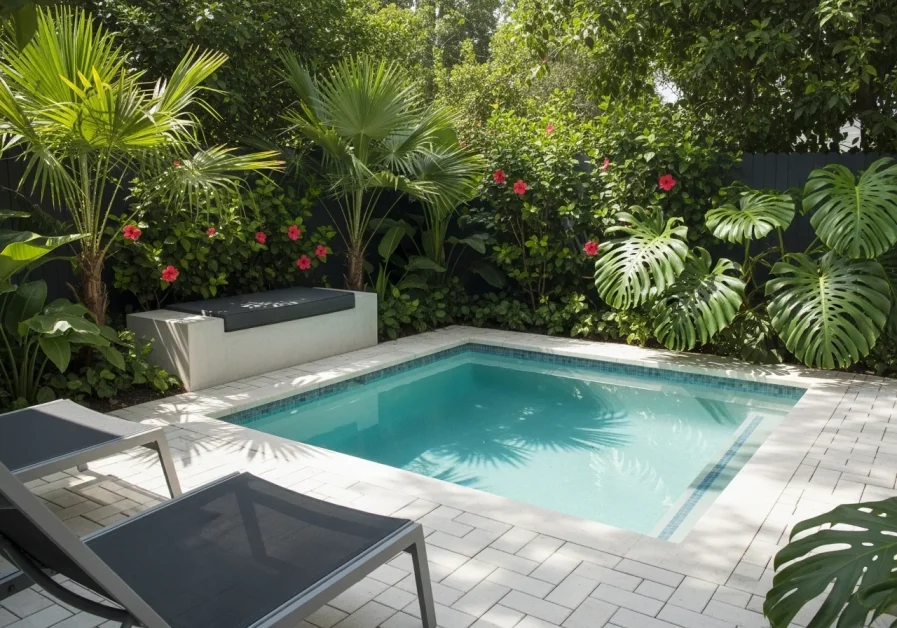
Some folks use them for cold plunging after workouts. Others treat them like a mini backyard escape, maybe with a waterfall, some mood lighting, and a glass of something chilled in hand. You can heat them, cool them, or just enjoy them at ambient temperature, depending on your setup.
As an Amazon Associate, we earn from qualifying purchases. This post may contain affiliate links, which means we may receive a small commission at no additional cost to you.
Now, if you’re seeing the term used in travel or nature contexts, it might refer to something else entirely. A plunge pool in geography means a natural pool found at the base of a waterfall. It forms when fast-moving water erodes the rock below, creating a basin that can be surprisingly deep, even if the waterfall isn’t that tall.
Here’s how the two compare:
| Type of Plunge Pool | Description | Common Use |
|---|---|---|
| Backyard/Home | Small, man-made, often heated or cooled | Relaxation, hydrotherapy |
| Geographic/Natural | Deep basin formed at base of a waterfall | Natural swimming, sightseeing |
Quick Facts at a Glance:
- Depth: Typically 4 to 7 feet
- Length: Often 6 to 12 feet
- Purpose: Cooling off, soaking, cold therapy, visual appeal
- Ideal For: Small yards, spa-like setups, wellness routines
People often pair plunge pools with modern landscaping or tuck them into patios. They’re also showing up more in boutique hotels, spas, and vacation rentals.
💧 Want to dig deeper into how plunge pools work and what to expect? Here’s the full guide with everything you’d want to know before adding one to your space.
Cold Plunge vs Cocktail vs Regular Pools: What’s the Difference?
Cold plunge tubs are best for recovery and wellness. Plunge pools work for compact relaxation, and cocktail pools are ideal for social soaking with friends.
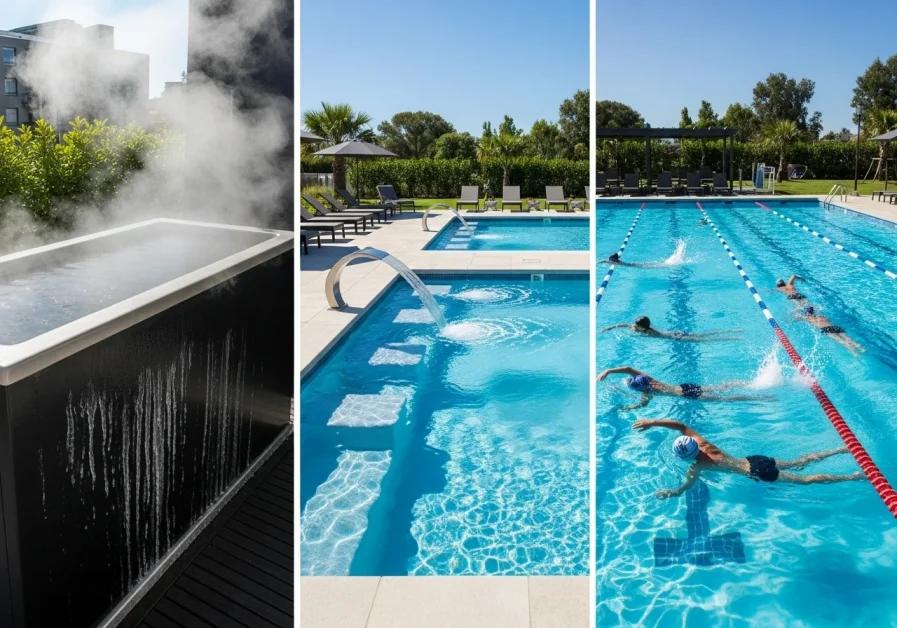
🧊 Cold Plunge Pool (or Cold Plunge Tub)
Cold plunges are exactly what they sound like: tubs or small pools designed to hold water around 50°F to 59°F. They’re built for short, intentional dips that help reduce inflammation, speed up recovery, and even improve mood. You’ll often see them in gyms, spas, or high-performance training facilities.
- Size: Usually built for one person, though some seat two
- Features: Cooling systems, durable materials, sometimes portable
- Best for: Athletes, wellness routines, post-sauna use
🌡️ Standard Plunge Pool
A plunge pool is a bit of a middle ground. It’s a compact, deep pool designed more for soaking or cooling off than full-on swimming. Unlike cold plunge tubs, they can be either heated or unheated, depending on how you want to use them. They’re a favorite for smaller backyards or patios with limited space.
- Size: Often 6 to 12 feet long, 4 to 7 feet deep
- Features: Optional heaters, basic filtration, sometimes jets
- Best for: Relaxation, space-conscious homeowners, spa vibes
🍸 Cocktail Pool
Cocktail pools are like the social butterfly version of a plunge pool. They’re slightly larger, typically come heated, and often include jets, seating, and lighting. Think of them as a mini-pool-slash-hot-tub made for entertaining.
- Size: Small to medium, often wider than plunge pools
- Features: Jets, built-in benches, heaters, LED lights
- Best for: Hosting, lounging, evening dips with drinks
📋 Side-by-Side Comparison
| Feature | Cold Plunge | Plunge Pool | Cocktail Pool |
|---|---|---|---|
| Temp | Cold only | Warm or cold | Warm |
| Size | Small | Small | Small to medium |
| Jets | Rare | Optional | Usually included |
| Purpose | Therapy (recovery) | Cooling, soaking | Relaxation, entertaining |
No one-size-fits-all here. If recovery and routine are your thing, a cold plunge might be perfect. Want something chill and compact that can be hot or cold? Go for a plunge pool. If your dream setup includes soaking with friends and drinks, cocktail pool’s the move.
💡 Still unsure which type suits your space and goals? Take a closer look at how plunge pool and hot tub combos work to get the best of both worlds.
As an Amazon Associate, we earn from qualifying purchases. This post may contain affiliate links, which means we may receive a small commission at no additional cost to you.
Plunge Pool Sizes, Shapes & Layouts
Plunge pools aren’t one-size-fits-all, but they are designed with space-saving in mind. Whether you’re working with a tiny backyard or an open patio, the right setup can feel like a luxury spa without eating up your entire outdoor space.
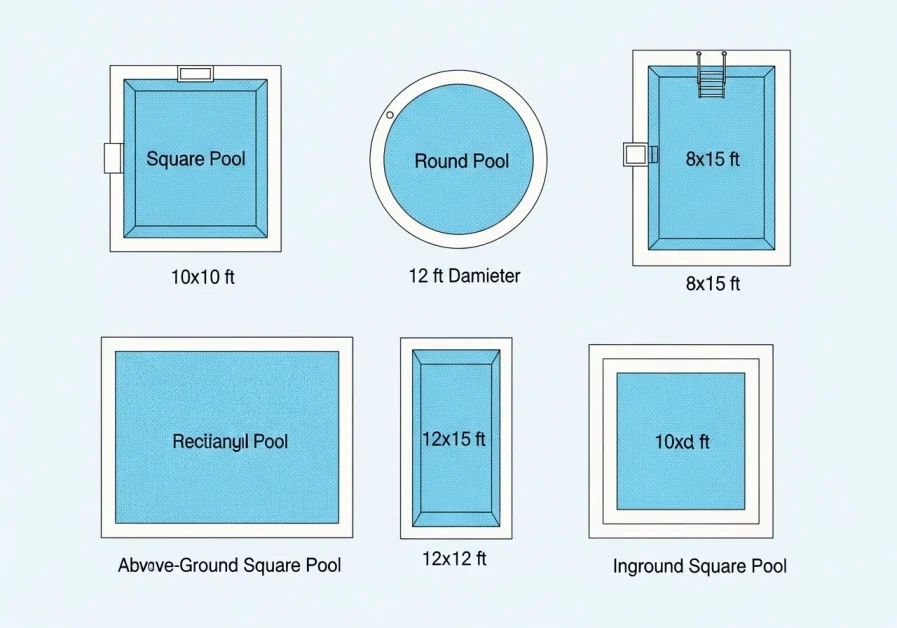
Typical Plunge Pool Dimensions
Most plunge pools fall into the following size range:
| Dimension | Typical Range |
|---|---|
| Length | 6 to 12 feet |
| Width | 5 to 8 feet |
| Depth | 4 to 7 feet |
They’re deep enough for a full-body soak but short enough to fit into tight spaces. Some are square, others rectangular, and a few even come with curved edges or corner-friendly shapes.
Inground vs Above Ground
Inground Plunge Pools
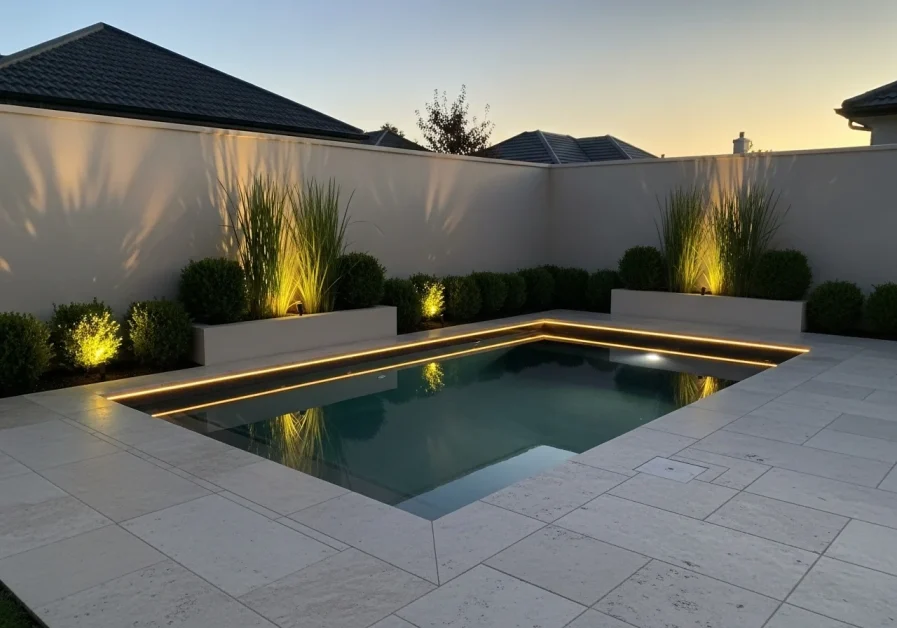
- Blends in with landscaping
- Offers a sleek, high-end look
- Often more durable long term
- Requires excavation and permits
- Higher installation cost
Above Ground Plunge Pools
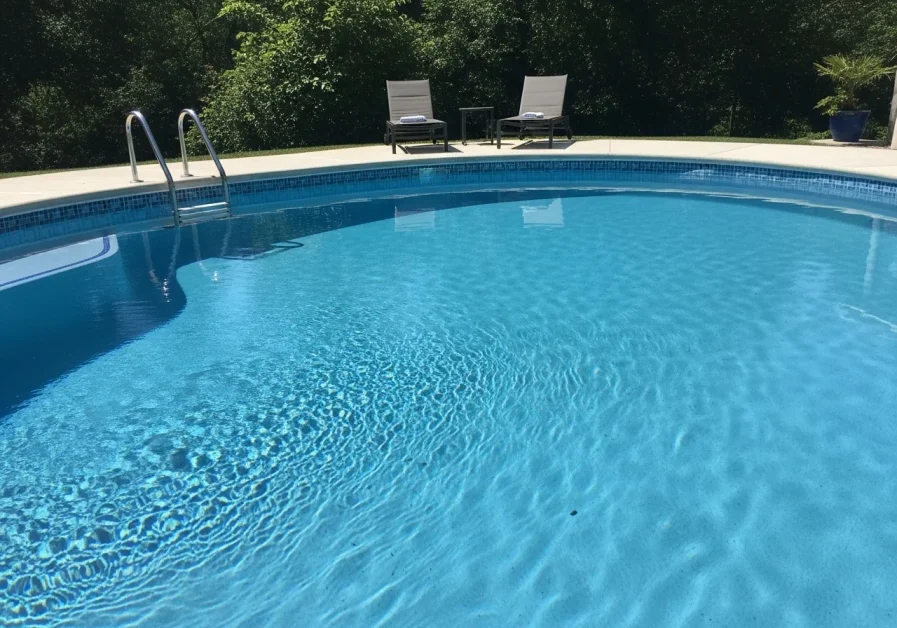
- Easier and faster to install
- Works well on decks, patios, or tight slopes
- Can be wrapped in wood, tile, or composite panels for aesthetics
- Typically more budget-friendly
- May require extra reinforcement or framing
Pro Tip: If your yard has elevation changes or limited access for heavy equipment, above ground can save you a headache.
Prefab vs Custom vs DIY
| Option | What It Means | Pros | Considerations |
|---|---|---|---|
| Prefab | Pre-built shell delivered ready to install | Fast, predictable costs | Limited size/style options |
| Custom | Built on-site to your specs | Fully tailored to your space | More expensive, longer timeline |
| DIY Kits | You install it yourself from a kit | Saves money if you’re handy | Requires tools, permits, know-how |
Prefab plunge pools are booming in popularity thanks to their simplicity and modern look. Many even come with built-in steps or seating.
🏡 Smart Layout Ideas for Small Yards
- Corner installs: Great for L-shaped patios or underused yard edges
- Deck integration: Drop it into a deck for a flush, built-in look
- Partial in-ground: Split the difference for style and access
- Side-yard setups: Use the long, narrow side of the house for privacy
You can get creative with surrounding features too, like a small waterfall wall, privacy fencing, or integrated planters.
Cost Breakdown & Buying Guide
If you’re sizing up whether a plunge pool is worth the investment, it helps to look at real numbers and long-term costs. Prices can swing quite a bit depending on whether you’re going for a prefab shell, a custom build, or a cold plunge tub.
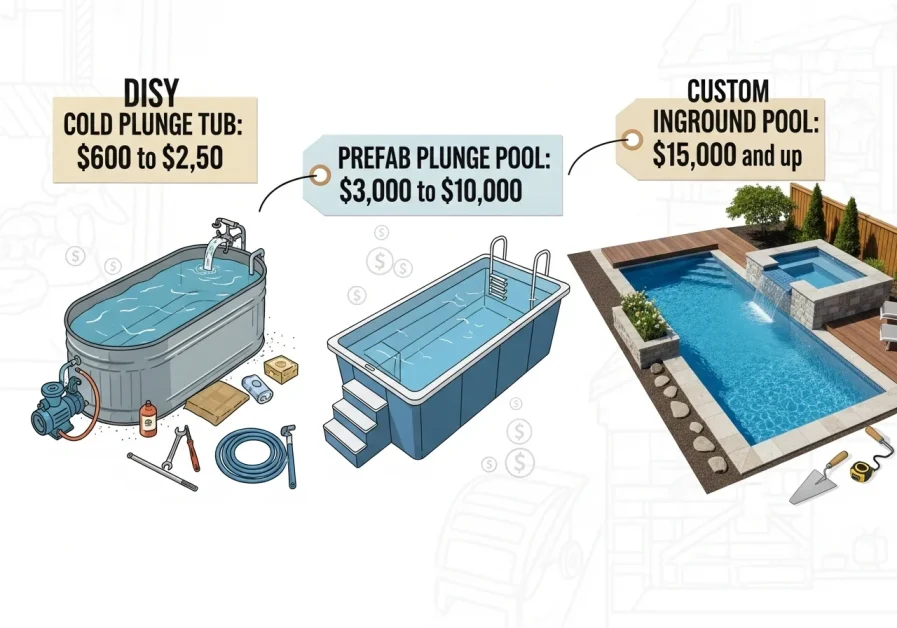
Average Price Ranges
Here’s a snapshot of what you might spend on different types of plunge pools:
| Type | Base Cost Range | Installed Cost (Approx.) |
|---|---|---|
| Cold Plunge Tub | $600 to $2,500 | Usually DIY or plug-in |
| Prefab Plunge Pool | $3,000 to $10,000 | $5,000 to $15,000 installed |
| Custom Inground Pool | $15,000 and up | $20,000 to $35,000+ |
These numbers cover the basics, like the shell, delivery, and standard plumbing. Custom finishes, heating systems, and decking can push costs higher.
🛠️ Installation vs DIY
Prefab and Cold Plunge Tubs
- Easier to handle without a pro crew
- Many models plug into a standard outlet
- Site prep still adds cost (like leveling, electrical wiring, or a concrete pad)
Inground Custom Plunge Pools
- Requires excavation, plumbing, and permits
- Almost always needs a licensed contractor
- Timeline is longer (6 to 12 weeks in many areas)
If you’re handy and have time, prefab plunge pools or cold tubs can be installed with basic tools. But for anything inground, expect professional help.
Maintenance Costs Over Time
Even small pools come with upkeep. Here’s what you’ll need to budget for each year:
- Chemicals: $200–$500
- Electricity (pumps, heaters): $300–$1,000
- Cleaning supplies or services: $150–$500
- Miscellaneous repairs: Varies
Cold plunge tubs cost less to maintain since they hold less water and typically don’t need as many chemicals.
Use Cases and Value
People usually buy plunge pools for different reasons, and each has its own payoff.
- Wellness and Recovery: Cold plunging helps reduce inflammation and improve circulation.
- Summer Cooling: Even unheated plunge pools are a relief on hot days.
- Luxury Feel: A sleek, modern plunge pool boosts backyard appeal.
- Space-Saving: Ideal for small yards or side-yard installs.
Is It Worth Getting a Plunge Pool?
Here’s a quick yes/no table to help you decide if it fits your goals:
| Situation or Goal | Worth It? |
|---|---|
| You want a place to cool off in summer | ✅ Yes |
| You need a full-size swimming pool | ❌ No |
| You’re serious about cold therapy and recovery | ✅ Yes |
| You plan to entertain big groups often | ❌ No |
| You have a small yard and want a low-profile pool | ✅ Yes |
💡 Need more details on how much you might spend? Here’s a deeper dive into the average cost of a small plunge pool so you can plan with confidence.
As an Amazon Associate, we earn from qualifying purchases. This post may contain affiliate links, which means we may receive a small commission at no additional cost to you.
Find One or Stay Somewhere with One
Not ready to commit to installing a plunge pool just yet? You don’t have to buy one to see what all the hype is about. Many spas, gyms, hotels, and rentals now offer plunge pools or cold tubs as part of their wellness amenities. Trying one out first is a smart way to see how your body responds and if it’s something you’ll use regularly.
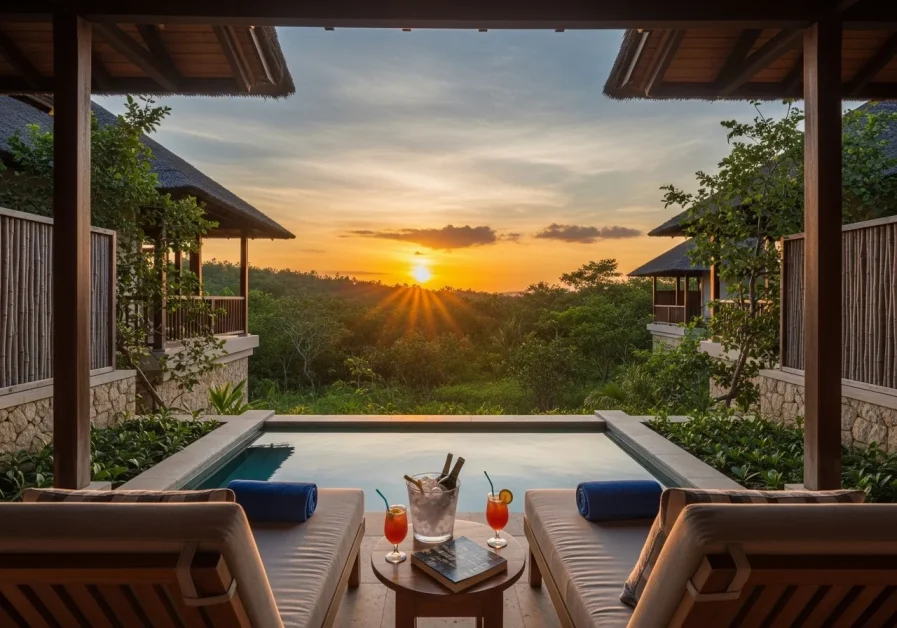
Try a Plunge Pool Before You Buy
Look around locally for these types of places:
- High-end gyms and recovery centers often have cold plunge tubs next to saunas
- Day spas sometimes offer private rooms with cold or warm plunge options
- Luxury hotels may have plunge pools near the spa or as part of premium suites
- Boutique wellness resorts often include them in hydrotherapy circuits
A quick search like “plunge pools near me” or “cold plunge therapy + [your city]” can lead you to a few solid options.
How to Search on Booking Platforms
Looking to combine your getaway with a trial run? Here’s how to search smarter on popular platforms:
On Airbnb:
- Use filters like Pool and Unique stays
- Add search terms like “plunge pool” or “cold plunge” to the keyword bar
- Look for “Spa retreat” or “Wellness” in listing titles
On Google Maps:
- Try search phrases like “hotels with plunge pools near me”
- Click on spa or resort listings, then scan photos or amenities
Pro Tip: Some listings use different terms, like “dipping pool” or “cool-down pool,” especially at resorts or in warmer climates.
Top Ideas for Your First Plunge Pool Experience
If you’re open to a mini getaway, here are popular U.S. destinations where plunge pools show up often:
| Destination | Why It Works | Try Searching For… |
|---|---|---|
| Sedona, AZ | Spa-focused desert retreats | “wellness resort plunge pool” |
| Palm Springs | Boutique hotels with stylish outdoor setups | “plunge pool hotel Palm Springs” |
| Asheville, NC | Forest cabins with spa-style decks | “Airbnb plunge pool Asheville” |
| Austin, TX | Cold plunge is trending in fitness spots | “cold plunge Austin spa” |
You could even create a small map embed on your site linking to local spas or resorts with plunge pools, depending on your target audience.
Pros, Cons & Who It’s Not For
Plunge pools check a lot of boxes, especially for people working with smaller outdoor spaces or looking to add a bit of luxury without the cost of a full-size pool. That said, they’re not perfect for every situation.
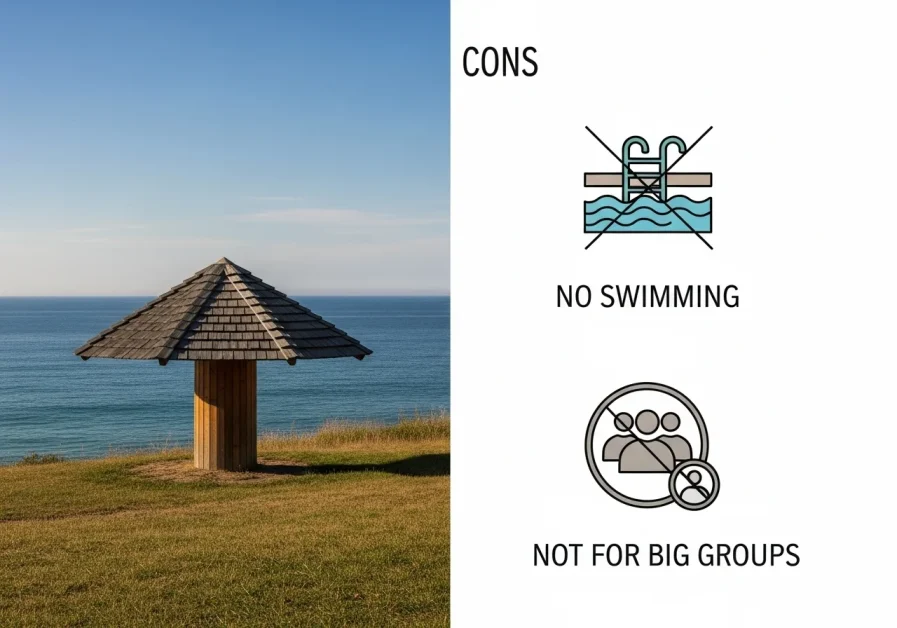
Here’s what works and what doesn’t.
Pros of a Plunge Pool
- Space-Saving: Most plunge pools are small enough to fit in tight backyards, patios, or side yards where a traditional pool wouldn’t make sense.
- Easier to Clean: Less water means quicker clean-ups, fewer chemicals, and lower maintenance overall.
- Wellness Benefits: Cold plunge options are great for recovery, circulation, and inflammation. Heated versions offer a spa-like soaking experience.
- Energy Efficient: Smaller volume = less heating or cooling time and lower utility bills.
- Modern Appeal: Compact pools with clean lines and water features can seriously upgrade your outdoor design.
Cons of a Plunge Pool
- Not Made for Swimming: If you’re imagining doing laps, a plunge pool isn’t it. These are made for soaking, not strokes.
- Still Can Be Pricey: High-end finishes, custom installs, or combining with hot tubs can push the budget up fast.
- Limited Capacity: Most plunge pools seat 2 to 4 people comfortably. They’re not built for big social gatherings or pool parties.
- Cold Water Shock Risk: For cold plunges, the water temp can be a shock to the system—something to consider if you have circulation or heart concerns.
Who Should Think Twice Before Getting One
| Type of User | Why It Might Not Be a Good Fit |
|---|---|
| People with heart conditions | Cold immersion can stress the cardiovascular system |
| Lap swimmers | Not enough space for proper swimming |
| Party hosts | Too small to entertain large groups comfortably |
| Those on a tight budget | Even the basics can cost several thousand dollars |
If you’re after a space to host summer pool parties or want a workout zone for serious swimming, a plunge pool may leave you underwhelmed.
💡 Still thinking it might work for your space and goals? Here’s what it takes to clean and maintain one without the hassle, so you know what you’re signing up for.
Which Option Fits Your Lifestyle?
Not sure which plunge-style setup fits your life (and your wallet)? Here’s a simple way to decide.
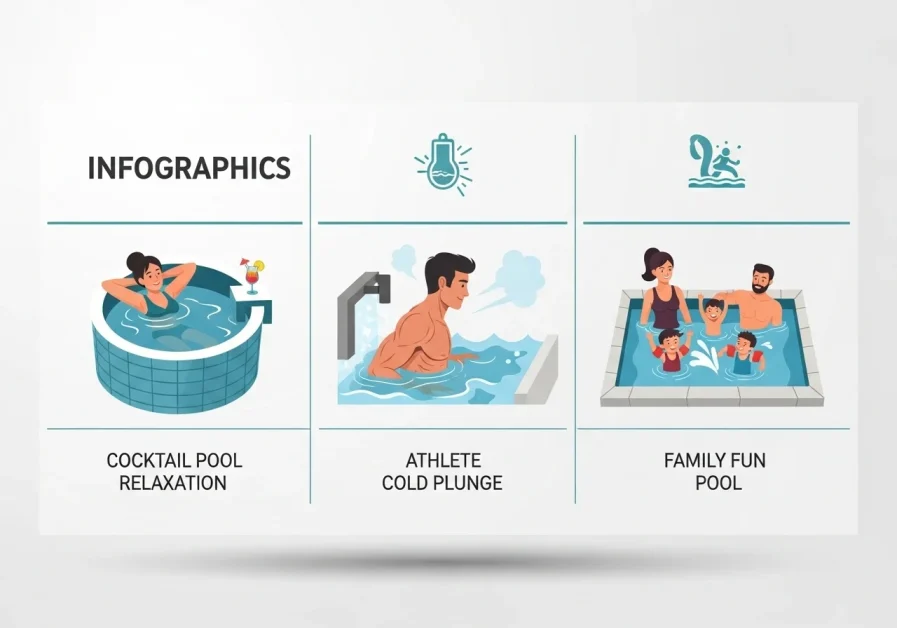
| Your Goal | Best Option |
|---|---|
| Muscle recovery | Cold plunge tub |
| Backyard lounging | Inground plunge pool |
| Budget-friendly | Above ground or prefab plunge pool |
| Entertaining guests | Cocktail pool |
| Luxury spa vibe | Heated plunge with a waterfall |
Quick Tip:
If you’re short on space or live in a warmer climate, a prefab plunge pool can be a smart, low-maintenance middle ground. Cold plunges are trending in wellness circles, but if you’re more about relaxation and entertaining, that cocktail-style pool with jets and warm water might be more your speed.

Inquiries still remain?
Are there concerns that were not addressed here? We’re here to help.
According to the Pool & Hot Tub Alliance, there are about 10.7 million residential swimming pools in the U.S., and smaller, wellness-focused installs like plunge pools are becoming one of the fastest-growing segments as homeowners look for compact spa-style options.
A University of South Australia study reviewed dozens of cold-water immersion sessions and found that short plunges (20–90 seconds at 50–59°F) improved stress levels and overall well-being. The researchers noted the effects last a few months but show clear short-term benefits for recovery and mood.
How to Install a Plunge Pool (Step-by-Step)
Thinking about adding one yourself? Here’s a simple breakdown of what the process looks like, whether you’re going prefab or custom.
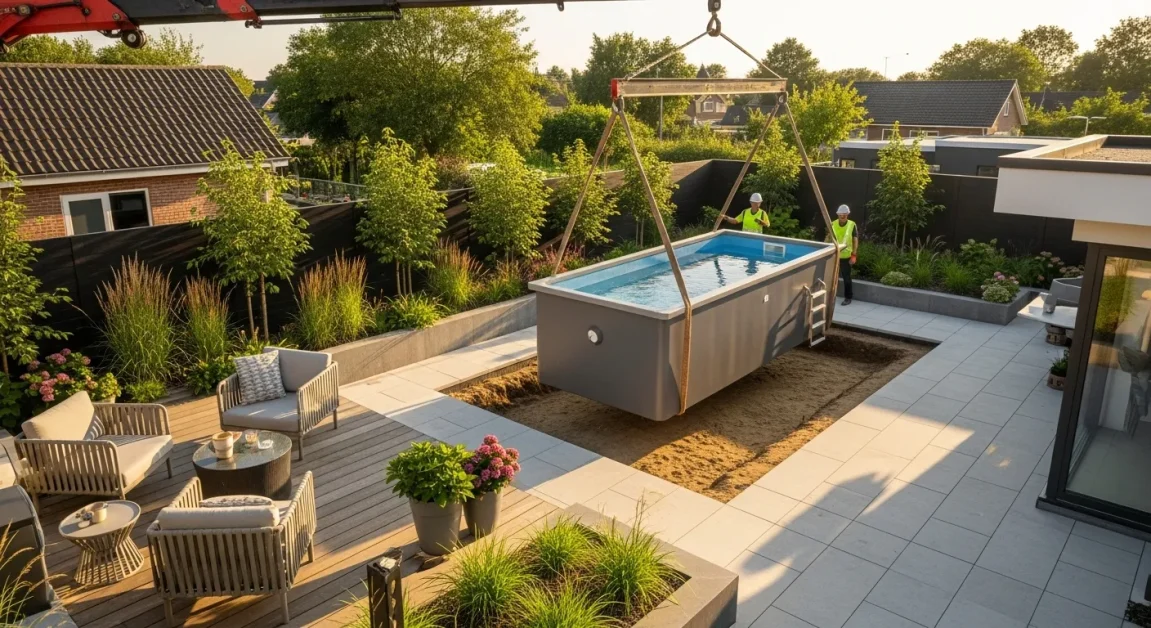
Step 1: Pick Your Spot
Choose a level area with easy access to water and electricity. Aim for at least 3 feet of clearance around the pool for maintenance and decking.
Step 2: Choose Your Pool Type
Decide between prefab, custom, or cold plunge tub. Prefab is fastest (2–3 days to install), while custom builds can take 6–10 weeks.
Step 3: Prep the Site
Clear the area, level the ground, and add a compacted gravel base or a small concrete pad for stability.
Step 4: Plumbing and Electrical Setup
Run plumbing lines for filling and draining. If you’re adding a heater or chiller, use a licensed electrician to handle wiring safely.
Step 5: Install the Pool
Lower the shell into place (with help or machinery, depending on size). Connect plumbing, add insulation if needed, and fill it up.
Step 6: Finishing Touches
Add decking, landscaping, or seating. Test water balance and filtration before your first dip.
Pro Tip:
If you’re using a prefab plunge pool, most brands include a setup video or online guide. Always double-check warranty conditions before DIY installs.
Real Example: Homeowner Case Study
Sarah from Austin, TX added a prefab plunge pool to her side yard for just under $8,000, including delivery and setup.
“It’s honestly the best part of summer evenings,” she says. “I use it after my runs three or four times a week, and the cold plunge makes recovery so much faster.”
Her setup takes up less than 100 square feet and blends into a small deck area with privacy panels and string lights. Maintenance is simple, she spends about 10 minutes a week checking the filter and adjusting the water balance.
Plunge Pool Winter Maintenance
Cold weather is hard on plunge pools, especially if they’re left untreated. A few smart moves now can save you from cracked plumbing, cloudy water, or a dead pump when spring rolls around.
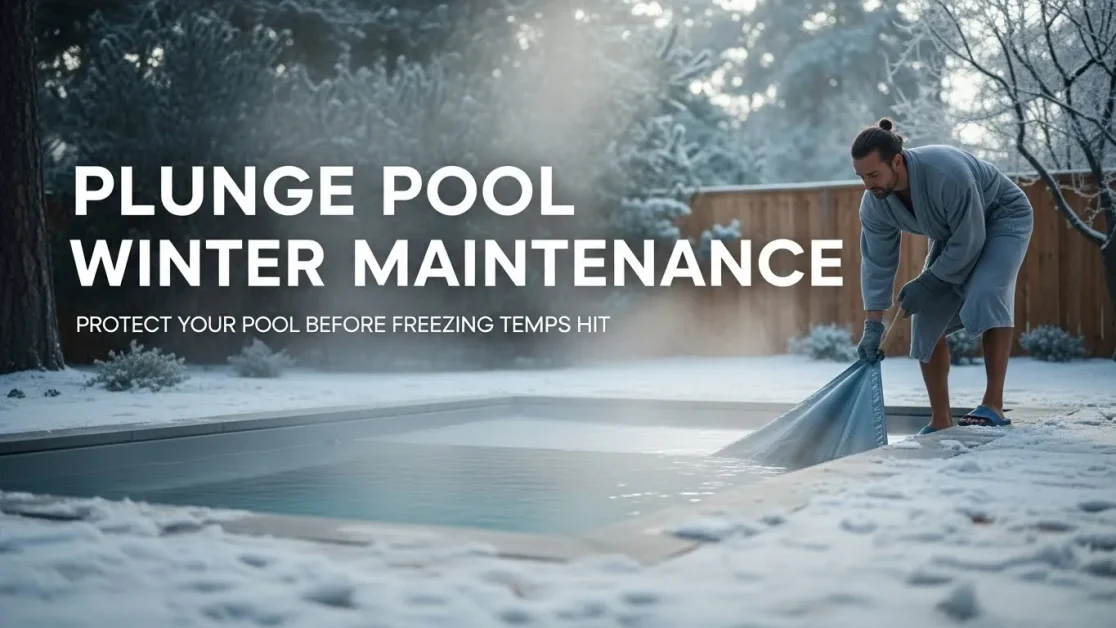
Decide First, keep it running or shut it down
Your winter plan depends on how you use the plunge pool.
- Cold plunge all winter: You’ll keep water in it, just managed differently.
- Seasonal use only: Full winterizing is safer and cheaper.
If you’re unsure, freezing temps below 32°F for long stretches usually mean winterizing is the safer call.
If you’re keeping the plunge pool active
This is common for cold therapy setups.
- Lower circulation time, don’t stop it
Run the pump at least once or twice daily. Moving water freezes slower than still water. - Watch water levels closely
Evaporation happens faster in winter. Low water can expose skimmers and freeze lines. - Dial back chemicals, not eliminate them
Cold water needs less sanitizer, but zero chlorine or bromine leads to biofilm and cloudy water. - Use a tight, insulated cover
Heat loss and debris are bigger problems than snow. Clear snow buildup so weight doesn’t stress the shell.
For balancing water without guessing in freezing conditions, tools like the hot tub water care guide help keep chemistry stable even when temps swing.
If you’re winterizing and shutting it down
This is where most damage happens if rushed.
- Drain completely
Don’t rely on gravity alone. Use a submersible pump to remove as much water as possible. - Blow out plumbing lines
Any trapped water can freeze and crack pipes. This step matters more than chemicals. - Remove and store filters indoors
Clean them, let them dry fully, then store somewhere above freezing. - Add non toxic pool antifreeze (if recommended by manufacturer)
Only for lines, never mixed into standing water. - Lock in with a winter rated cover
Secure it tight so melt water doesn’t seep back in.
If you want a deeper step by step breakdown, the winterizing your hot tub process applies almost exactly to plunge pools with similar plumbing layouts.
